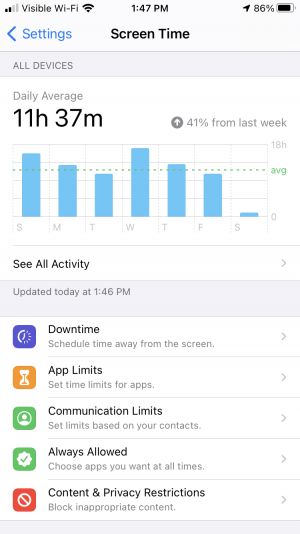Screen time's effect on adolescents mental health
Screen time is the aggregate time spent using a device with a digital screen, which can include computers, smartphones, tablets, TV's, and video games. There are five different categories of screen time: social, passive, interactive, educational, and other[ref], and all five categories in excess show negative psychological effects. It is measured in hours per day. Mental Health is defined by the World Health Organization as a state of well-being whereby individuals recognize their true abilities, are capable of coping with the normal stresses of life, and are capable of productively and joyfully contributing to their communities. The effects of screen-time on young users' mental health is an emerging area of research of the 21st century. Adolescents 18-29 comprise the highest proportion of smartphone users, making up 96% of the market share of mobile phone ownership. Studies show that excessive mobile screen time is significantly associated with depressive symptoms. The true extent to which screen-time affects mental health is still being researched, which could inform decisions on regulation.
Contents
PHYSICAL HEALTH
Screen time has been proven to have a negative linear relationship with physical activity, which is a key attribute in mental health. Physical activity boosts confidence, lessens depression and anxiety, and improves sleep quality. Children who watched TV for a long period of time demonstrated reduced participation in physical activities. In a survey of Iranian students, those who were categorized as having high screen time usage of over 2 hours per day and the low level of physical activity of exercising 1-2 days per week were independently associated with self-reported psychological distress by reporting symptoms of depression, anger, insomnia, worthlessness, confusion, anxiety and worry. In the same study, students with high physical activity and high screen time reported less psychological distress than students with high screen time and moderate physical activity, suggesting that physical activity can improve psychological well-being irrespective of screen time. High screen time also increases the chance of engaging in unhealthy behaviors that harm the physical body, such as consuming fattening food, smoking, drinking alcohol, using tobacco, and leading a life of inactivity. Inactivity is linked to psychological disorders, including anxiety and depression. There is an indirect link between screen-time and worser mental health due to the physical repercussions.
PSYCHOLOGICAL SYMPTOMS
Excess screen time in adolescents has been linked to depression and anxiety.
THEORIES OF USE
Total screen time is linearly associated with unfavorable temperament outcomes, worse socio-emotional outcomes, lower health-related quality of life, and poorer health outcomes. There are more varied effects for the different categories of screen-time.
SOCIAL
Social screen time encompasses all digital social interactions, including direct messaging, social media, and FaceTime calls. Social screen time has improved the happiness of some because forming social relationships is a key indicator of someone's well-being and the digital technologies can help connect people in the information age. There was a notable increase in children’s social screen time between the ages of 12 and 14 as they develop more autonomy. However, children who spent the highest amounts of time on the internet tended to be the least happy. Social screen time was linearly associated with higher reactivity, and worse socio-emotional outcomes. Social screen time does not influence hyperactivity.
PASSIVE
Passive screen time encompasses any digital activity in which the user is an observer of digital content. Some examples are watching TV and scrolling on social media. Of the five categories of screen usage, it has the most detrimental effects on adolescents' well-being. It is associated with worse psychological effects, including poorer pro-social behavior and lower persistence.
INTERACTIVE
Interactive screen time encompasses digital activity that requires the user's input, such as video games. It shows similar affects as overall screen time, however it can have positive effects on education.
EDUCATIONAL
OTHER
describe w effects
MODERATION
REGULATION
-parents? self-regulation? There is a need to regulate the digital social connectedness which can be established by mindful and healthy digital habits that can promote a balance between plugging in and unplugging, consequently impacting well-being and mental health. t is impossible to abstain from screen time in modern times. Oftentimes, the most successful tactics to minimize technology harm are not technical at all, but behavioural such as self-imposed limitations on use of digital platforms, using non-digital means when possible and using digital platforms for better health and well-being.
Moderate amounts of electronic screen time are associated with higher mental well-being compared to low or high levels Goldilocks effect proven good sometimes
